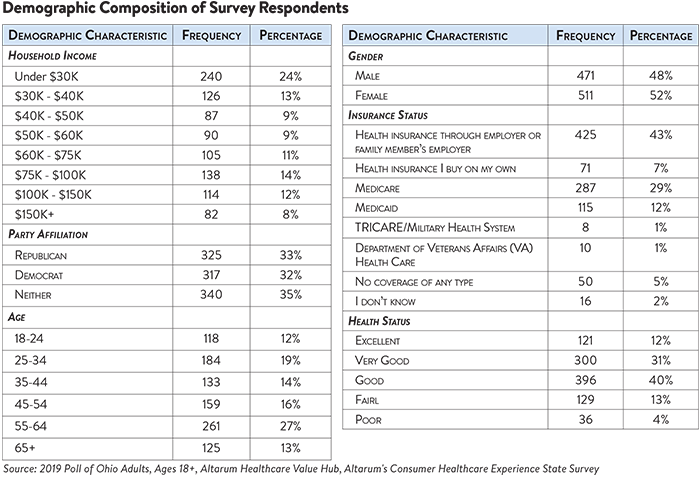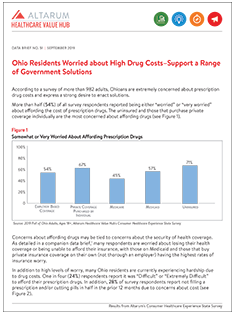Ohio Residents Worried about High Drug Costs–Support a Range of Government Solutions
According to a survey of more than 982 adults, Ohioans are extremely concerned about prescription drug costs and express a strong desire to enact solutions.
More than half (54%) of all survey respondents reported being either “worried” or “very worried” about affording the cost of prescription drugs. The uninsured and those that purchase private coverage individually are the most concerned about affording drugs (see Figure 1).

Concerns about affording drugs may be tied to concerns about the security of health coverage. As detailed in a companion data brief,1 many respondents are worried about losing their health coverage or being unable to afford their insurance, with those on Medicaid and those that buy private insurance coverage on their own (not thorough an employer) having the highest rates of insurance worry.
In addition to high levels of worry, many Ohio residents are currently experiencing hardship due to drug costs. One in four (24%) respondents report it was “Difficult” or “Extremely Difficult” to afford their prescription drugs. In addition, 28% of survey respondents report not filling a prescription and/or cutting pills in half in the prior 12 months due to concerns about cost (see Figure 2).

In light of concerns about high healthcare costs—including prescription drug costs—it is not surprising that Ohio residents are extremely dissatisfied with the health system:
- Only 26% agree or strongly agree with the statement “We have a great health care system in the U.S.”
- While 75% agree or strongly agree “the system needs to change.”
When given more than 20 options, the option cited most frequently as being a “major reason” for high healthcare costs were drug companies charging too much money:
- 75%—Drug companies charging too much money
- 65%—Hospitals charging too much money
- 63%—Insurance companies charging too much money
- 50%—Some well-known or large hospitals or doctor groups using their influence to get higher payments from insurance companies
When it comes to tackling high drug costs specifically, respondents endorsed a number of strategies:
- 90%—Authorize the Attorney General to take legal action to prevent price gouging or unfair prescription drug price hikes
- 88%—Set standard prices for drugs to make them affordable
- 88%—Require drug companies to provide advanced notice of price increases and information to justify those increases
- 88%—Prohibit drug companies from charging more in the U.S. than abroad
What is remarkable about the findings is high support for change regardless of the respondent’s political affiliation (see Table 1).
While government action was strongly viewed as more effective to address high drug costs, respondents also saw a role for themselves in solving problems. They reported actions they have already taken, like researching the cost of drug beforehand (58%), as well as future actions—81% are willing to switch their brand drug for a generic if there's a cost savings.
Note
1. See: Healthcare Value Hub, Ohio Residents Struggle to Afford High Healthcare Costs; Support a Range of Government Solutions Across Party Lines, Data Brief No. 49 (September 2019). www.healthcarevaluehub.org/Ohio-2019-Healthcare-Survey/
Methodology
Altarum’s Consumer Healthcare Experience State Survey (CHESS) is designed to elicit respondents’ unbiased views on a wide range of health system issues, including confidence using the health system, financial burden, and views on fixes that might be needed.
The survey used a web panel from SSI Research Now containing a demographically balanced sample of approximately 1,000 respondents who live in Ohio. The survey was conducted from March 21st through March 28th, 2019 only in English and restricted to adults ages 18 and older. Respondents who finished the survey in less than half the median time were excluded from the final sample, leaving 982 cases for analysis with sample balancing occurring in age, gender and income to be demographically representative of Ohio. After those exclusions, the demographic composition of respondents is as follows.









